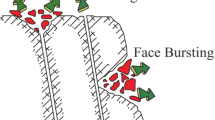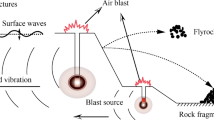Abstract
In blasting operations, the main purpose is to provide appropriate rock fragmentation and to avoid adverse effects such as flyrock and vibration. This paper presents the applicability of least squares support vector machines (LS-SVM) for estimating the blast-induced flyrock. For comparison aim, support vector regression (SVR) was also employed. The case study was carried out in the Gole-E-Gohar iron mine of Iran in which the values of burden to spacing ratio, hole length to burden ratio, subdrilling, stemming, charge per delay, rock density and powder factor were measured for 90 blasting operations. The mentioned seven parameters were used as the independent or input parameters in modeling, while, the values of flyrock distance were assigned as the models output. To train the models, 72 datasets were adopted and then the remaining 18 datasets were adopted to test the models. The models performance was compared by several statistical criteria such as R square (R 2) and mean square error (MSE). According to obtained results, the LS-SVM with the R 2 of 0.969 and MSE of 16.25 can prove more useful than the SVR with the R 2 of 0.945 and MSE of 31.58 in estimation of blast-induced flyrock. At the end, sensitivity analysis was also performed and according to the results, powder factor and rock density were the most effective parameters on the flyrock in this case study.






Similar content being viewed by others
References
Khandelwal M, Singh TN (2009) Prediction of blast-induced ground vibration using artificial neural network. Int J Rock Mech Min Sci 46:1214–1222
Singh TN, Verma AK (2010) Sensitivity of total charge and maximum charge per delay on ground vibration. Geomat Nat Hazards Risk 1(3):259–272
Monjezi M, Khoshalan HA, Varjani AY (2012) Prediction of flyrock and backbreak in open pit blasting operation: a neurogenetic approach. Arab J Geosci 5:441–448
Verma AK, Singh TN (2013) Comparative study of cognitive systems for ground vibration measurements. Neural Comput Appl 22:341–350
Sari M, Ghasemi E, Ataei M (2014) Stochastic modeling approach for the evaluation of backbreak due to blasting operations in open pit mines. Rock Mech Rock Eng 47(2):771–783
Dindarloo SR (2015) Prediction of blast-induced ground vibrations via genetic programming. Int J Min Sci Technol 25(6):1011–1015
Hasanipanah M, Bakhshandeh Amnieh H, Arab H, Zamzam MS (2016) Feasibility of PSO–ANFIS model to estimate rock fragmentation produced by mine blasting. Neural Comput Appl. https://doi.org/10.1007/s00521-016-2746-1
IME (1997) Glossary of commercial explosives industry terms. Institute of Makers of Explosives, Washington
Monjezi M, Mehrdanesh A, Malek A, Khandelwal M (2013) Evaluation of effect of blast design parameters on flyrock using artificial neural networks. Neural Comput Appl 23:349–356
Yari M, Bagherpour R, Jamali S, Shamsi R (2016) Development of a novel flyrock distance prediction model using BPNN for providing blasting operation safety. Neural Comput Appl 27(3):699–706
Ghasemi E, Sari M, Ataei M (2014) Development of an empirical model for predicting the effects of controllable blasting parameters on flyrock distance in surface mines. Int J Rock Mech Min Sci 52:163–170
Ghasemi E, Amini H, Ataei M, Khalokakaei R (2014) Application of artificial intelligence techniques for predicting the flyrock distance caused by blasting operation. Arab J Geosci 7:193–202
Trivedi R, Singh TN, Raina AK (2014) Prediction of blast induced flyrock in Indian limestone mines using neural networks. J Rock Mech Geotech Eng 6:447–454
Rezaei M, Monjezi M, Varjani AY (2011) Development of a fuzzy model to predict flyrock in surface mining. Saf sci 49(2):298–305
Khandelwal M, Monjezi M (2013) Prediction of flyrock in open pit blasting operation using machine learning method. Int J Min Sci Technol 23:313–316
Sharma LK, Vishal V, Singh TN (2017) Predicting CO2 permeability of bituminous coal using statistical and adaptive neurofuzzy analysis. J Nat Gas Sci Eng. https://doi.org/10.1016/j.jngse.2017.02.037
Ahmad M, Ansari MK, Sharma LK, Singh R, Singh TN (2017) Correlation between strength and durability indices of rocks-soft computing approach. Proced Eng 191:458–466
Singh R, Umrao RK, Ahmad M, Ansari MK, Sharma LK, Singh TN (2017) Prediction of geomechanical parameters using soft computing and multiple regression approach. Measurement 99:108–119
Sharma LK, Singh R, Umrao RK, Sharma KM, Singh TN (2017) Evaluating the modulus of elasticity of soil using soft computing system. Eng Comput 33(3):497–507
Sharma LK, Vishal V, Singh TN (2017) Developing novel models using neural networks and fuzzy systems for the prediction of strength of rocks from key geomechanical properties. Measurement 102:158–169
Rajabi M, Rahmannejad R, Rezaei M, Ganjalipour K (2017) Evaluation of the maximum horizontal displacement around the power station caverns using artificial neural network. Tunn Undergr Space Technol 64:51–60
Rezaei M (2016) Development of an intelligent model to estimate the height of caving–fracturing zone over the longwall gobs. Neural Comput Appl. https://doi.org/10.1007/s00521-016-2809-3
Amini H, Gholami R, Monjezi M, Torabi SR, Zadhesh J (2012) Evaluation of flyrock phenomenon due to blasting operation by support vector machine. Neural Comput Appl 21(8):2077–2085
Trivedi R, Singh TN, Gupta NI (2015) Prediction of blast induced flyrock in opencast mines using ANN and ANFIS. Geotech Geol Eng 33:875–891
Monjezi M, Rezaei M, Yazdyan Varjani A (2009) Prediction of rock fragmentation due to blasting in Gol-E-Gohar iron mine using fuzzy logic. Int J Rock Mech Min Sci 46(8):1273–1280
Monjezi M, Rezaei M, Yazdyan A (2010) Prediction of backbreak in open-pit blasting using fuzzy set theory. Expert Syst Appl 37(3):2637–2643
Suykens Johan AK, Tony, Van Gestel, Jos De Brabanter (2002) Least squares support vector machines. World Scientific, Singapore
Basak D, Srimanta P, Dipak Chandra P (2007) Support vector regression. Neural Inf Process Lett Rev 11:203–224
Smola AJ, Bernhard S (2004) A tutorial on support vector regression. Stat Comput 14:199–222
Mahdevari S, Shahriar K, Yagiz S, Akbarpour Shirazi M (2014) A support vector regression model for predicting tunnel boring machine penetration rates. Int J Rock Mech Min Sci 72:214–229
Bao Y, Xiong T, Hu Z (2014) Multi-step-ahead time series prediction using multiple-output support vector regression. Neurocomputing 129:482–493
Espinoza M, Suykens Johan AK, De Moor B (2005) Short term chaotic time series prediction using symmetric LS-SVM regression. In Proceedings of the 2005 international symposium on nonlinear theory and applications (NOLTA), Bruges, Belgium, pp. 606–609
Sananda K, Khare D, Mondal A (2017) Future changes in rainfall, temperature and reference evapotranspiration in the central India by least square support vector machine. Geosci Front 8:583–559
Ji J, Zhang CS, Gui YL, Lü Q, Kodikara J (2017) New observations on the application of LS-SVM in slope system reliability analysis. J Comput Civil Eng 31(2):1–9
Castro-Garcia R, Suykens JAK (2016) Wiener system identification using best linear approximation within the LS-SVM framework. In Proceedings of the 2016 IEEE Latin American conference on computational intelligence (LA-CCI), Cartagena, Colombia
Yang Y, Zang O (1997) A hierarchical analysis for rock engineering using artificial neural networks. Rock Mech Rock Eng 30:207–222
Hasanipanah M, Monjezi M, Shahnazar A, Jahed Armaghani D, Farazmand A (2015) Feasibility of indirect determination of blast induced ground vibration based on support vector machine. Measurement 75:289–297
Hasanipanah M, Naderi R, Kashir J, Noorani SA, Qaleh AZA (2017) Prediction of blast-produced ground vibration using particle swarm optimization. Eng Comput 33(2):173–179
Hasanipanah M, Jahed Armaghani D, Bakhshandeh Amnieh H, Majid MZA, Tahir MMD (2016) Application of PSO to develop a powerful equation for prediction of flyrock due to blasting. Neural Comput Appl. https://doi.org/10.1007/s00521-016-2434-1
Hasanipanah M, Jahed Armaghani D, Monjezi M, Shams S (2016) Risk assessment and prediction of rock fragmentation produced by blasting operation: a rock engineering system. Environ Earth Sci 75:808
Acknowledgements
The authors thank the technical team and personnel of Gol-E-Gohar iron mine for their helps in gathering of data for this work. The authors are also interested to express his genuine gratitude to other persons who kindly gave us their worthy advises in the paper preparation.
Author information
Authors and Affiliations
Corresponding author
Ethics declarations
Conflict of interest
The authors declare that they have no conflict of interest.
Rights and permissions
About this article
Cite this article
Rad, H.N., Hasanipanah, M., Rezaei, M. et al. Developing a least squares support vector machine for estimating the blast-induced flyrock. Engineering with Computers 34, 709–717 (2018). https://doi.org/10.1007/s00366-017-0568-0
Received:
Accepted:
Published:
Issue Date:
DOI: https://doi.org/10.1007/s00366-017-0568-0




